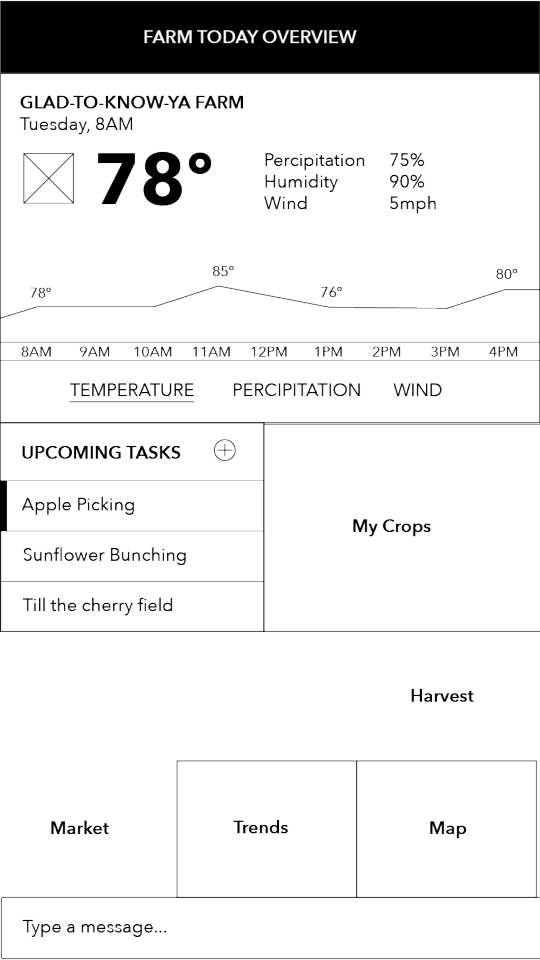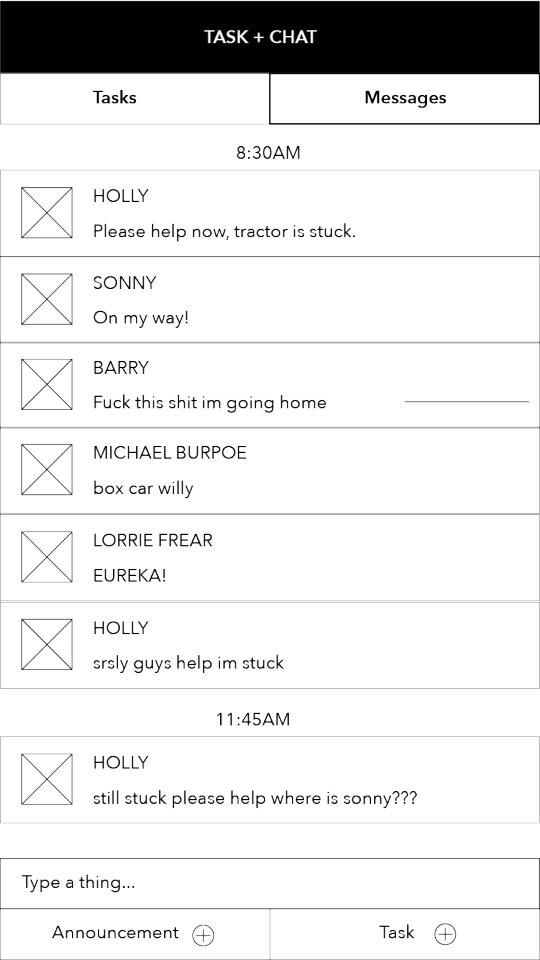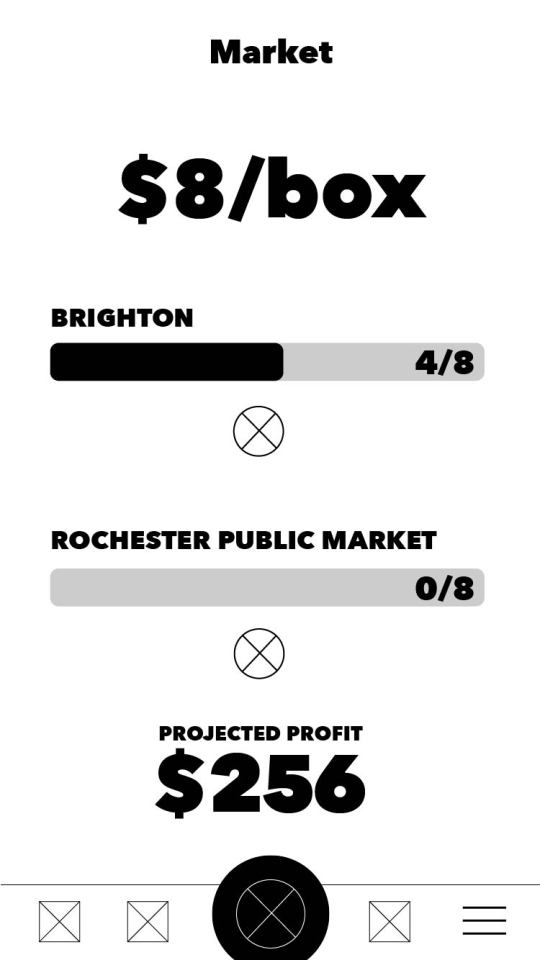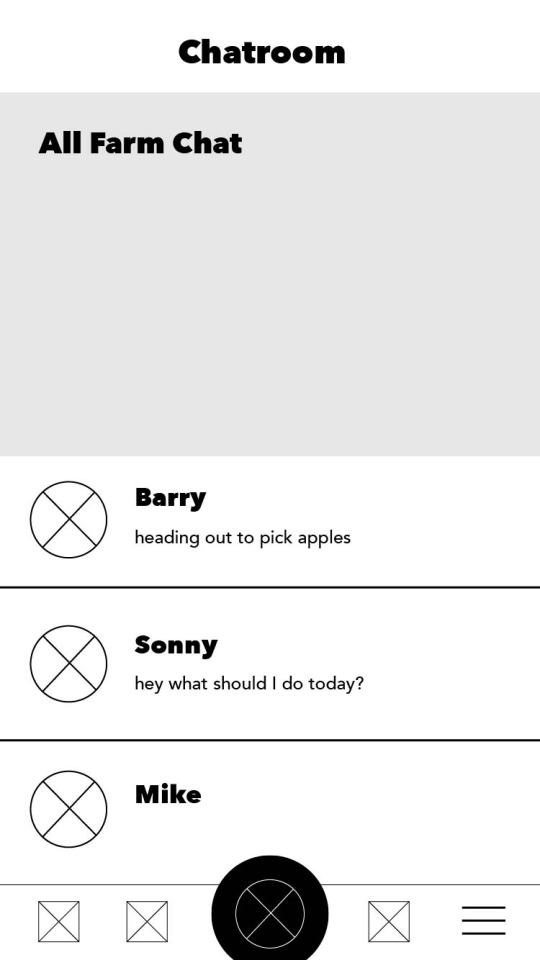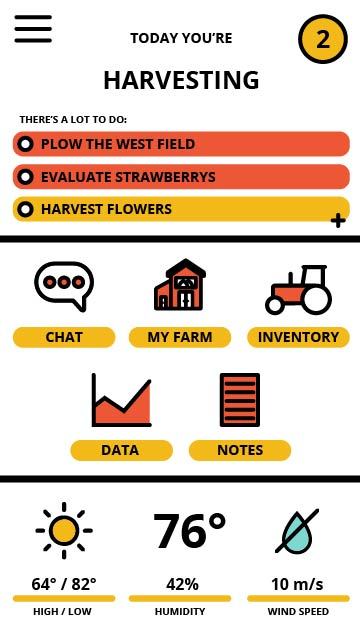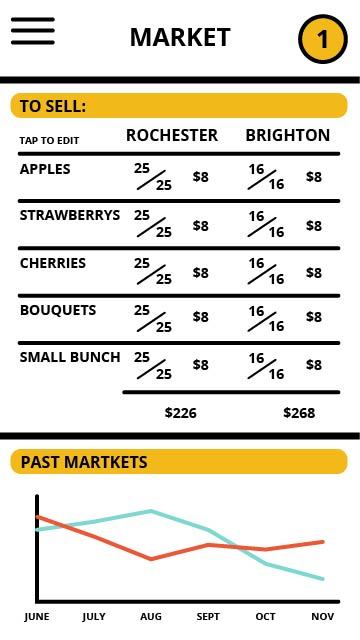Photo
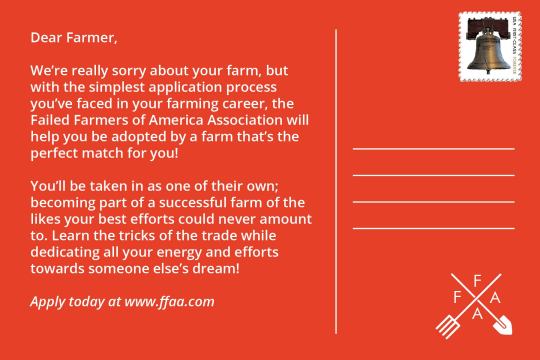

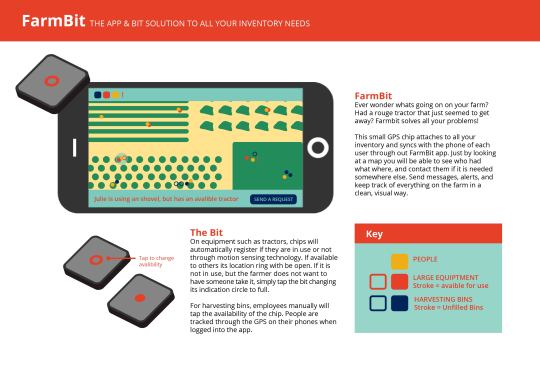
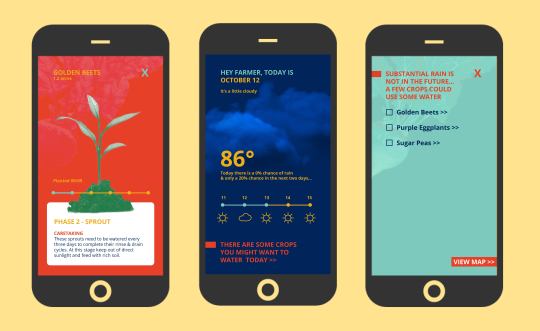
1) Inspired by the word WHALES
Whales actually adopt rejected animals such as dolphins as their own. Because of their accepting nature I was inspired to create FFAA a spoof of future farmers of America- failed farmers of America association. I made a postcard that would be sent to failing farmers.
2) Something multiple people can use at once
I made FarmBit, a little GPS inventory tracking system where a little bit is attached to anything you want to keep track of. Workers can then use their phones to see what is where and get help ext.
3) Sticky note inspired
Lots of people said weather control and stuff like accurately predicting weather. I made an app that analyzed the percentage of rain and suggests what crops to water and what ones to hold off on. It also tracks growth and what the needs are of plants at different stages.
0 notes
Photo


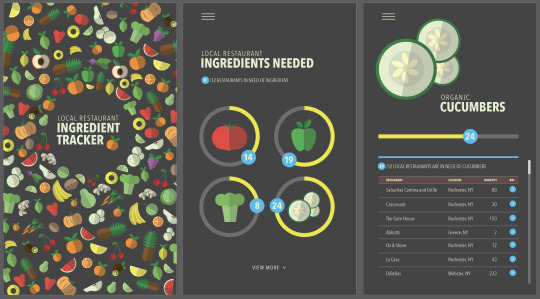
Andrea’s Rapid Prototyping
Post-It word: NERD - This prototype is based off my word nerd. I think that people who wear things like Google Glass look pretty nerdy, hence the creation of a Google Glass for farmers on tractors!
Farmer Simon Says - An app that more than two people could use at once. I was inspired by talking to many farmers who said they have trouble communicating who is doing what. When things come up, they text each other, so the idea is it is streamlined and Farmer Simon can tell people to do things (since he’s the boss-man)!
Post-It idea: App to Track Produce/Product needs of restaurants - This is based on the idea that restaurants could say what ingredients they are searching for, then farmers could place bids on which they would want to supply.
*NOTE* These are just prototypes and for the sake of time, I did not illustrate any of the icons or people you see here!! They are vectors from Freepik.com
2 notes
·
View notes
Photo



Mimi’s Rapid Prototyping
The Sticks & Stoned food truck was drawn from the “hippie van” post-it note. Selling edibles made with weed grown by local farmers, this truck is a great way to bring light to pot farmers and all the hard work they do.
The Transfarmer was created with inspiration from the post-it note reading “siri on tractors.” It is a mix of a robot and a John Deere tractor. It is very efficient. Good for the farm.
The farmer kissing booth is a great way for the community to get to know the person who grows their food. In a very intimate way. Kissing is a great way to bond.
#small farms#farmers market#weed#pot farming#barns#kisses#transfarmer#john deere#uiuxdesign#prototype#illustration#farmlife#horsegirl#mimi
3 notes
·
View notes
Photo
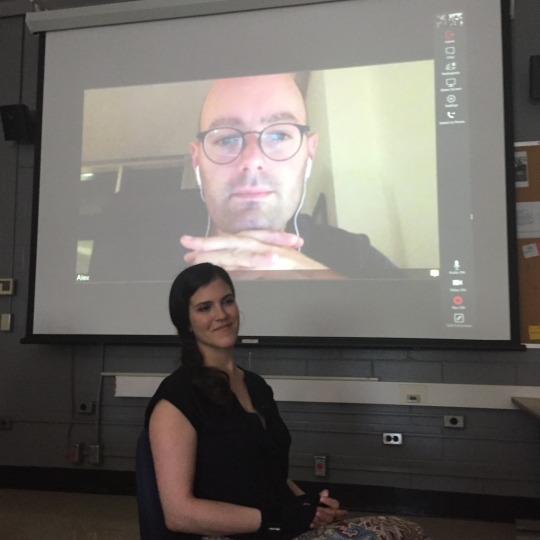
chats with ALEX CHEEK today!
0 notes
Text
RIT Student - Part Time Farmer on Family Farm
What type of farm do you own/work on?
We own and operate an 80 acre Vegetable farm. Of the plot, I would say approximately 60 is farm Land. We started as a simple roadside corn stand but are slowly growing into our own farmers market, adding new things each year.
Do you use any technology to aid in your farming processes? If so, what kinds?
To start with the most basic I would say different Tractors based on the task at hand. The work there is the generic stuff you could assume. The more unique tech would have to be the little things. Recently we purchased an "air cannon" which is a propane based noise maker that we place in the corn fields to ward off hungry birds. We also have caged pressure traps (they just trap them, no spikes cutting feet) that we use to relocate raccoons or other critters to a family members farm. For irrigation, we have a pretty generic scheme. A hose runs from the house and is split into different channels. From the split, drip lines are buried in the soil to irrigate the crops that require more water than the average rainfall can supply. There are so many little bits of tech that we use for optimizing our work it would take more than a few pages to explain it properly.
What item or aspect makes running your farm the most difficult on a day-to-day basis?
Every one of us works a full-time job on the side or is attending school full time. We only recently acquired a family friend to help during this time. At best, we only have 2-3 people available. Some days when there is no other option, my father will wake up at 4am, work to supply enough produce until noon, where he will come home on his lunch break and work enough to restock until he gets home from work around 4:30. From there he'll work until around 8pm, sometimes later if needed. To summarize, we've become bigger than we can support with just our immediate family, but hiring outside help can be nerve racking in an agricultural environment ( it's dangerous.) So right now we split a full-time job for more than 4 people between our free time.
Can you explain every method and tool you use to track inventory?
We pick everything on a day to day basis. our inventory is how much we need for the day. This ties into our problem with full-time jobs. We can't just do the work on an off day because it will lose freshness....... That being said, there is no inventory model other than seeing how much we have and asking yourself if it will be enough to get to the end of the day.
For Straw bales, we have a counter on the baler that counts the number. There is a notepad in the house that you write the number on. If someone buys straw, you subtract the number they purchased from the count.
Chemical Inventory is much more strict. Due to all of the regulations, we keep clean books including volume applied to each acre, what the chemical was, how much water it was mixed with and where it was applied. Good times.
You have an inventory of actual goods, are there any other supplies or goods you have to keep an inventory of on the farm?
See the part about chemicals above!
When selling your goods, how do you keep track of everything, including stock, money, etc?
Money wise...Solid bookkeeping. we count it by hand each day.
When it comes to stock, we just keep checking our stock and if it's running low we grab more from the store room. If the store room is low, we pick more. After years of running things, you develop a sense for how much stock you will need based on the day of the week and weather.
I hope this helps a little. Of everything, I would stress that inventory for chemicals is mostly paper bookkeeping, but very strict. We use tech for irrigation and pest control. We split a large operation with very few people due to the dangers of hiring someone who would be irresponsible.
0 notes
Photo

Dori Eder
Gemini Valley Farm, Menomonie, WI
What type of farm do you own/work on?
Our farm is a 9 acre diversified small livestock farm. We raise lamb, geese and ducks on pasture as well as quail for eggs.
Do you use any technology to aid in your farming processes? If so, what kinds?
We're pretty low-tech on the actual production side. Our most important tool is portable electric fencing, which might not sound impressive but it's a fairly recent innovation that has revolutionized grass-based livestock farming.
What item or aspect makes running your farm the most difficult on a day-to-day basis?
Our business happens in the context of nature, which is unpredictable. Increasingly, farmers can no longer rely on historical weather patterns to plan their farm enterprises. Ill timed rains, early or late frosts, hail, excessive heat can all wreak havoc on the best laid plans.
Can you explain every method and tool you use to track inventory?
We do an annual inventory of all that we manage with a pen and paper (we utilize Holistic Management as a system of whole farm planning/management which has fairly proscribed steps involved).
I use Excel spreadsheets to track each type of livestock and to manage customer orders. I use a field notebook/calendar to keep production notes. I use Quickbooks to track sales and expenses. You have inventory of actual goods, are there any other supplies or goods you have to keep inventory of on the farm?
For the quail egg business, we keep an inventory of cartons, labels and egg cleaning supplies. We also keep an inventory of promotional materials including product labels, invoice forms, thank you cards, etc.
For livestock at various stages, we also keep track of feed. When we buy feed, we use certified organic feeds which have limited shelf-life, so feed is generally purchased in smaller quantities. I keep careful track of these purchases because they're our single biggest expense.
When selling your goods, how do you keep track of everything, including stock, money, etc?
All our meat sales are direct to customers, and I keep track of each customer order via Excel spreadsheet. I use Quickbooks to track all farm expenses and income and a field calendar for production and health notes for each type of stock.
0 notes
Text
Directed Storytelling
The method I used for research this time was called Directed Storytelling. This is a process of rooted in the social science method of narrative inquiry where researchers understand people through the stories they tell. I directed the interviews by asking them to tell a story about their typical farm experience. From there guiding questions revolving around details gave a deeper knowledge and focus into their interests, career hopes and farming opinions.
After a brief introductory background I asked them the question:
Can you tell me about a typical day on the farm?
Stacy
Brief Background
Interested bc friend had a greenhouse about 6 years ago
saw it was easy to eat well
currently works on a farm in hayfield colorado
biodynamic- focus on planting with the moon, when the moon is close to the earth its pushing towards the earth, the time of wanting roots (carrots potatoes onions) pulling away, plant leaves flowers and fruit
first farm in Santa Barbara CA avocado orchard and organic vegetable
trying to learn how to teach
wants her farm to have a lot of aspects, small herds of animals too, mushrooms, bees, vegetables, 3-4 acres
How is she prepping for her own farm
growing at her home, learning from farms, going to school for biology
when she has the money she will know
putting away money and then loan, lots of grants for greenhouses too
southwestern colorado, 3 acres, 1 acre of garden
Is she hesitant?
Yes, not a money making job
but work really hard
wintertime can’t really grow
figures if she becomes a scientist she can do that in the winter and farm in the summer
Can you tell me a typical story of your day on the farm
wake up at 6, eat
30 min drive, has to be there around 8
2 types of days- major harvest or weeding
harvest days
-carts to put bins in
-when harvesting salad put in mesh bags in buckets, later dip and dry
-in the field cover with wet towel to keep fresh
greenhouse- tomatoes, pick and weed everything by hand
weeding days- weed nonstop, hoeing or down on the ground
plant in an order theres always something to harvest
every tuesday salad and every friday need salad , but monday too
keep written inventory on spreadsheet
have map of garden based off headers of irrigation
write how much is pulled and what is going where
issue- hard to calculate everything ex tomatoes are just starting to make money but hard to see how much put in
growth output is calculated
Issues?
lower parts in the field get lower ph
just kind of work through and harvest what you can
How do they track?
collect how much is being pulled from each row per pound
How do they control irrigation?
irrigation system water is nearby reservoir, fills up their pond that has 2 outlets, pump goes to overhead sprinklers so they can control it
manual control, they turn it on
Is there any distribution issues?
currently shortage of local food, they’re main contributor of salad mix
farmers market is 1/2 of where they make the $ from, full price not whole sale
Anything else?
nice culture
a lot of fun, watch hawks, mountains,
Zach
Had family members who worked on farm, interested in doing a personal one down the road- purely a side thing not for profiting and selling purposes, more hobby and home food, smaller scale, leafy greens, vegetables
does not have a lot of research into it but interested in more classic farming methods
Grew up in an area with a lot of farmers, especially animal ones, the main was cow farmer - Palmer dairy- supplies to most of upstate, most familiar with that
to make money as a farmer you really have to own a big farm
gotta wake up early
machine milked
farmer knew them all by name- Cows were tagged but not branded
other farms he worked on grew beans corn, grown in rotation, roots put nutrients in
palmer guy would take tires, tax breaks
Joe
Medicinal pot for chronic sleeping issues and pain
Barn, different stages of plant life, babies need certain wavelength of light yellow LED, feel it a lot of nutrients and not water for sprouts!
when they’re a foot tall goes into a bigger room with good air circulation and the temp is always 70 with 50% humidity, lights two feet above plants at whole process
mid life (3 ft) move them to bigger pots, once weight makes them fall get a thin cargo net and hangs it so the the leaves grow on top and hold it up
do for 2 months, feeding a little water lots of nutrients
(all time controlled)
5ft tall, move into another bigger room, different light natural light, keep temp same budding phase, (starts flowering bc the new light) cut back on nutrients and “flush” more water for less chemicals when smoked, goes for 3 months
Ready to cut, plant is dead :( can’t really recycle, not efficient
Senior year went to florida and did online high school while playing hockey, went to niagara, dropped out and became electrical, hated it, decided to grow pot- lifelong dream achieved
Dad married daughters best friend, got his medical card, then he got his med card, grew for the two of them, started growing for other people, about 30 plants total 12 flowering, 12 growing, 12 babies
Each plant yields 1-2 pound, grows to 14 ft tall in 100 gallon drums
middle in 50, babies in like 5
super profitable now, dad gave starting money, renting barn
Why not full time?
currently mom isn’t a huge fan, just been doing it for about 2 years, wants to go into full time, interest in going into botany making new strands and stuff
light cycles are timed PERFECTLY same everyday,14 hr light 10 of darkness, also air circulation, buys 5000 ladybugs bc they eat microscopic insects on plants
doesn’t really keep inventory bc its small and manageable, part-time, and partly illegal
Still figuring out how big space heater and cooling systems and dehumidifier needed, lots of nutrients, waters with 6 barrels that get filled with rain water, hoses by hand, big desk where he mixes nutrients in
trimming needs to be done as it goes, pick brown leaves as close to stem as it can
0 notes
Text
Persona Organization
The first organization method we did for our personas involved categorizing them from conventional to unconventional at the same time as if our product would affect their decisions or habits. From there we explained our placement and had the class put up suggested ideas to look into on notes surrounding our persona for further research.
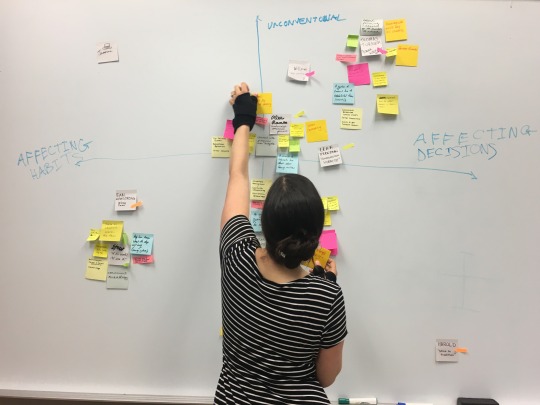
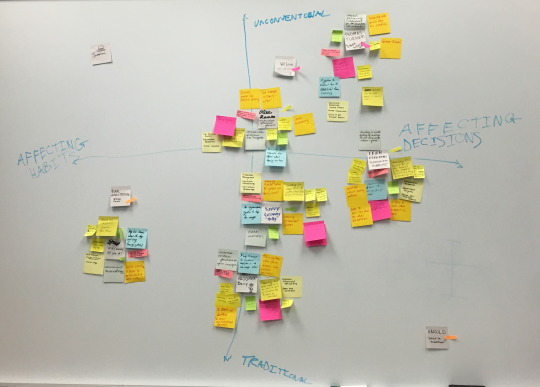
Our personas were placed as follows:
Daisy, early bloomer - Traditional but in the middle of affecting habits and decisions
Willow, eager sprouter - up on the unconventional scale, and leaning a bit more towards affecting decisions over habits
Holly, savvy grower - on the way down towards traditional leaning ever so slightly towards affecting decisions
Class Notes
Daisy

Holly
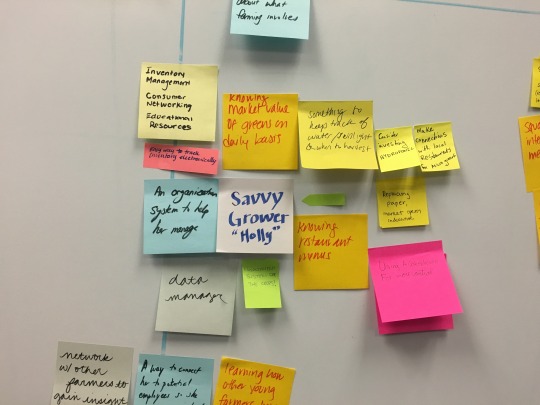
Will - we did not do all 3, just the 2 primary, so we photographed the notes for Thomas and Alex who are other group personas similar to will
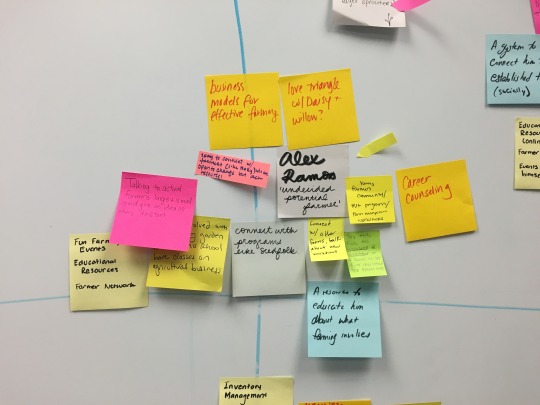

0 notes
Photo





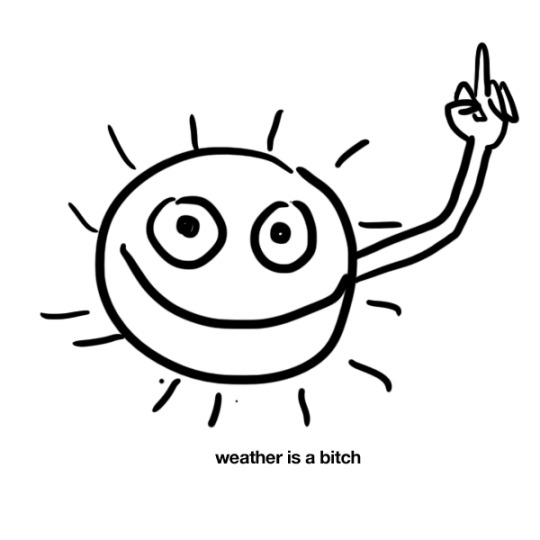
I just wanted to go to the Public Market and just have conversations and meet people, but I picked storyboarding for my “research method.” In the context of this project, storyboards provide a visual narrative that can communicate a situation in which technology could be used.
Almost every single person so far from my previous interviews and interviews this past weekend has said weather is the most frustrating part of farming. This scenario is a tribute to the struggles of weather.
Weather is a bitch.
One farmer I talked to in particular gave me a lot of insight to how the test out a new product. On their farm, they will give the new product a few years to see
1. How well it grows on their land, figure out what the product needs in order to grow properly, experimentation, etc, and
2. How well it sells at market.
They currently do not record this information, but they thought it would be very helpful to have records of past information.
We talked awhile about integrating technology in the form of a database system, and she was very excited by that idea. Having the ability to pin-point records from previous growing seasons and compare them to the current season would help farmers figure out how exactly the plants respond to certain conditions. Technology that could generate visual comparisons in the forms of user-friendly graphs and charts would be amazing; the lady I spoke to isn’t interested in (or good at) math and would love to be shown information than have to calculate anything.
Important factors that could be recorded automatically would be the weather; including rainfall, humidity, wind, hours of sunlight. All of these affect plant growth. Manually inputted could be the amount of crops harvested, the amount sold, any additional watering, etc. Notes.
Although the lady told me it is nearly impossible to follow and track trends at market, I still feel a record of sales from market to market could be significant in discovering which market tends to buy the most of their product in general.
A database system could help farmers farm smarter and more strategically. This could make farming more efficient by maybe saving time during the trial/error period, as well as providing instant, honest, logged information from the past instead of relying on memory.
1 note
·
View note
Text
The Receptivity Gradient
David Rose's Receptivity Gradient
This chart is a tool for appropriately targeting audiences. Users are plotted in “beginning” spots along a scale of 5 steps- not ready to know, ready to know, ready to hold an opinion, ready to act, ready to advocate. By placing target audiences/personas in an initial position, designers can target the true “needs” and “purposes” of their project. The end goal is typically to advance the personas two or three places forward along the scale towards ready to advocate.

The Results

Our 3 personas ended up being placed as follows:
Daisy (early bloomer) ready to know / ready to have an opinion
Daisy has grown up farming and unsure if she wants to follow in her family footsteps. Since she has a lot of experience she is a good position to have an opinion, but also is open to learning more about how to make a sustainable living off of what she sees as a high input, low output career.
Holly (savvy grower) ready to have an opinion
Holly is very established in her career and is open to improvements, but has a good system and is happy with what she is doing. Because of her open mind, but great knowledge, she is a respectable candidate to offer an opinion on a product.
Willow (eager sprouter) Ready to act
Will is not very knowledgeable or established in the farm community, but he is open to information and ready to dive in. He just needs the funds and comfort of knowing it will all be sustainable.
Taking it a Level Up

We decided to add a Y axis to the chart, on a scale of qualified to unqualified. This shifted our personas a bit. Daisy was raised a little bit since she is very knowledgeable about the farm base as was Holly who was put near the top. Will was dropped down to unqualified as he lacks the knowledge and experience needed to have an heavy opinion. However, being lowered on the Y axis is not bad, it just helps really narrow the target audience.
0 notes
Photo

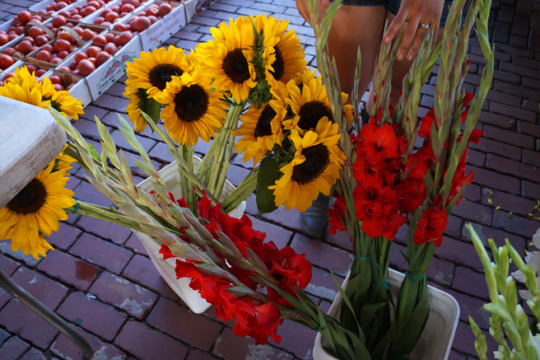
I met the nicest lady in the entire world yesterday at the market!
This is Julie, and she works on Glad-To-Know-Ya Farms in Wayne County. She not only talked to me for well over a half hour, but she invited me to visit the farm whenever I’d like, and said her and her family are more than willing to answer questions. We have really similar personalities and instantly clicked.
She falls under the Early Bloomer persona, but after college, she came back to the farm because she missed it so much. I gained a lot of insight to why younger people want to stay in farming from talking to her; I would love to explore that feeling more by creating a short documentary for the Experiential Narrative project. Her mom, dad, and brother all have different views on farming as well, and it would be incredible to talk to each of them.
Initially I only stopped to talk to farmers who sold produce, and skipped the stands that had meats and eggs, herbs and plants, jarred goods, etc, but I’m really happy I said hi to Julie. I was going to move on because it looked like they only sold flowers, but I thought that flower farming would bring an interesting perspective to my research and I had no reason to limit it to produce (They apparently not only sell flowers, but also apples, strawberries, and cherries as well!)
Julie is an excellent example of an educated, millennial farmer who couldn’t be happier with her life as a farmer. She not only enjoys working on the farm, but also loves educating people about farming. She is a great role model for the younger generation.
I can’t wait to work with her more! Talking to her made me so excited to continue researching.
0 notes
Photo




I went to the market alone and talked to a lot of strangers.
I found a Mushroom Man who grew a lot of mushrooms.
Mushrooms are very temperamental and sensitive to sunshine.
0 notes











